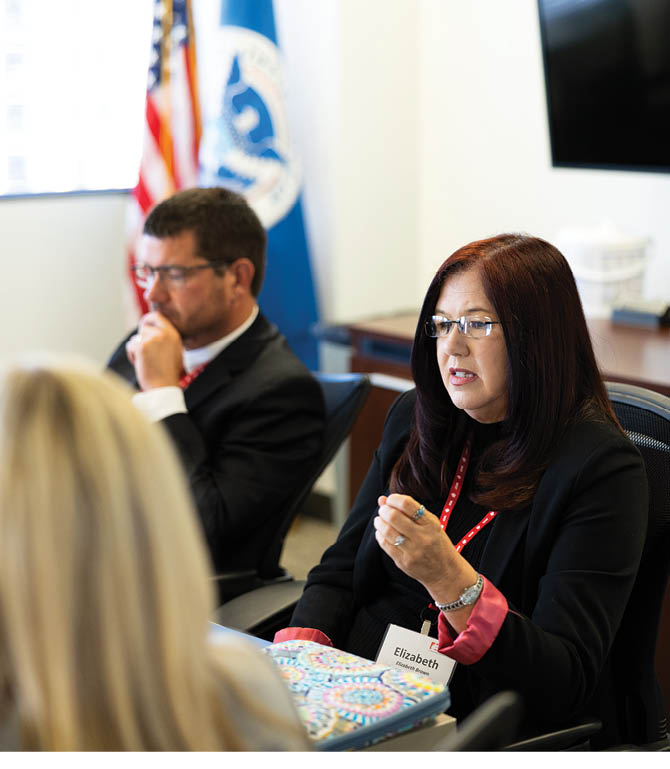Making a Difference

Since its release last summer, “The Guide to Recovery” has done exactly what it was supposed to do: help school leaders in the aftermath of school shootings. Produced by NASSP’s Principal Recovery Network (PRN), a group of current and former school leaders who have experienced gun violence in their buildings, the guide has also spurred school leaders in general to think more about school safety and act to improve it. And most recently, it has opened the door to high-level meetings in Washington, D.C., between PRN members and officials from the White House, federal agencies, and Congress.
Over two days in June, PRN members met with staff from the U.S. Department of Homeland Security’s Cybersecurity and Infrastructure Agency (which oversees a number of initiatives related to school safety); top officials at the U.S. Department of Education, including Secretary Miguel Cardona; members of the White House Domestic Policy Council, including President Biden’s chief education policy advisor; and numerous senators and representatives during lobbying visits to Capitol Hill.
“Our voice is very important, and people see that,” says Greg Johnson, the principal of West Liberty-Salem High School in West Liberty, OH, and co-facilitator of the PRN. “This guide has taken our influence to another level and brought more attention to our group and what we’re doing. There’s a reason why people want to sit with us and hear us. They value our opinion.”

Elizabeth Brown, the other PRN co-facilitator who is principal of Ocali Charter High School in Ocala, FL, says the meetings were the best the group has ever had because they were talking to “the people who are on the front lines of the decision-making as far as what the federal government does with school safety, and they pass that down to the states. This was a really productive meeting as far as moving forward with our advocacy piece and with our agenda.”
Personal Stories and Practical Advice
Since it was founded in 2019, the PRN has assisted more than 50 school leaders in the immediate aftermath of a crisis. The pace of school shootings unfortunately shows no sign of slowing, so that number will inevitably rise in the years to come. Last August, the group distilled its collective wisdom about the most useful advice following a tragedy into “The Guide to Recovery.” It’s a combination of personal stories and practical advice, much of which may be completely unfamiliar to those who haven’t dealt with a similar crisis.

“I just spoke to a principal who was not aware of the guide. When she read it, she found it very helpful,” says Michelle Kefford, the principal of Marjory Stoneman Douglas High School in Parkland, FL. “There’s no document like it. Certainly, we wish we didn’t have to produce it for obvious reasons. But I think having the guide as a tool is helpful, and it will help others facing similar situations.”
One of those leaders who found the guide invaluable was Kacy Shahid, the newest PRN member and the former principal of Central Visual and Performing Arts High School in St. Louis, MO. Shahid says she consulted the guide regularly after a shooting at her school in October 2022. “It was a critical time, and we sometimes didn’t know what our first, second, or third step was going to be. We were just trying to get through it. The guide gave me assurance and some steps to follow.”
Shahid’s experience also illustrates a challenge the PRN regularly faces when reaching out to school leaders following a shooting. So much is going on that the principal can be overwhelmed by calls, emails, and texts. And unfortunately, hoaxes and additional false threats are not uncommon.
Ty Thompson, the former principal of Marjory Stoneman Douglas High School, was the first PRN member who reached out to Shahid to help. He also offered her a copy of the guide. “I remember thinking, ‘Right, come on. You’re just going to send me this information?’ So, I just ignored it,” she recalls. But when he and other PRN members followed up, eventually she realized it was not a hoax, and she discovered how useful the guide was.
Reaching Out After an Incident
Many PRN members have reached out to school leaders in the wake of a shooting, and they say that just getting a principal’s attention can be challenging. Greg Johnson says he often contacts a number of different people at the school, not just the principal, and includes a copy of the guide. “There’s a good chance it won’t actually get through to anybody right away because they’re getting bombarded,” he says.
Eventually, Johnson says, he usually receives an email from the principal expressing thanks, and that often leads to an ongoing connection. “I think it takes a little while before the principal realizes that this isn’t just going away, and things aren’t going back to normal next week. We’re in it for the long haul.”
Brown adds that once she has been able to talk to principals, she’s built some solid relationships. “I’ve heard from principals that ‘The Guide to Recovery’ is the most useful piece of literature they’ve had on their desk as far as being able to make sure that they’re doing what they need to do for their students.”
The Washington meetings showed the PRN members the range of resources that different federal agencies are working on related to school safety, some of which the group was unaware of. The federal leaders the group met with were eager to continue their discussions with NASSP and the PRN, with the common aim of enhancing school safety and preventing violence.
“It opened my eyes to see that there are other organizations that are making a similar effort,” Johnson says. “If we could work together and collaborate on that, I think we could be even more effective, so I think that’s one of the next steps that will come out of these meetings.”
Praise From the Secretary of Education
In his meeting with the group, Secretary of Education Cardona told them, “I appreciate you being here. We need to hear from you and have that influence what we do here. You’re turning your experience into something that will help others.”
The group members, who often say they are part of a club no one wants to be a part of, have a strong connection based on their shared experiences. Shahid noticed it in her first PRN meeting. “This is a group of such selfless and courageous leaders who are out there for our communities and our students and staff. I’m grateful for the connections I’ve made with them, even though I don’t like the circumstances. I feel like I can pick up the phone and call someone whenever I need.”
Parkland’s Principal Kefford says she’s grateful to NASSP for putting together and supporting the PRN. “We’re working collaboratively and making great strides in bringing to light the seriousness of this issue, as well as potential solutions, to try to help our colleagues and to try to help the education system in general.”
Brown, the co-facilitator, remains optimistic that the PRN’s efforts will eventually help lead to a day when its members have no reason to call principals after another tragedy. “But we’ll keep working for as long as it takes,” she says. “I know we truly make a difference.”
To contact the PRN and request a copy of the guide, visit nassp.org/advocacy.

Dan Gursky is a freelance education writer and editor based in Washington, D.C.
